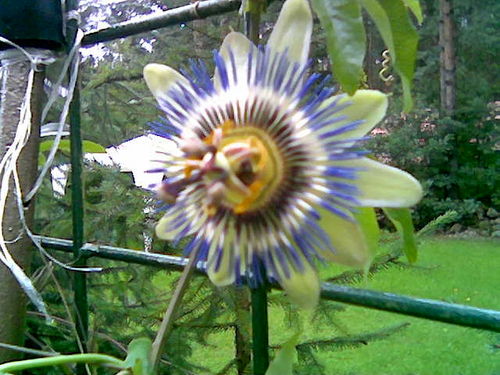Passiflora zwana Męczennicą
Autorem artykułu jest Ryszard MarszałekPnącze to pochodzi przede wszystkim z tropikalnych lasów deszczowych Ameryki Środkowej i Południowej, a głównie z terenów Meksyku i Brazylii. Nazwę swoją wywodzi z elementów kwiatu, w których rzekomo widać narzędzia tortur i mękę ukrzyżowanego Jezusa.
Znanych jest ok. 450 gatunków Passiflory, z czego w uprawie stosuje się ok 10. Rośliny uprawia się przy podporach, do których mocuje się ona za pomocą czepnych wąsów. Są roślinami wymagającymi wielu czynników. Powinny być umieszczane czy to w ogrodzie, czy też na balkonach w pełnym słońcu - wówczas najlepiej kwitną. Wymaga również dosyć intensywnego nawożenia w okresach dekadowych nawozami wieloskładnikowymi. Potrzebują także częstego podlewania (w okresach upałów nawet 2 razy dziennie), ale bez spowodowania efektu nadmiernego nawilgocenia, co może skutkować gniciem korzeni. Wskazane jest również częste zraszanie liści wodą. Nie należy dopuszczać, aby nowe pędy czepiały się wąsami starszych, gdyż to bardzo osłabia roślinę.

Passiflora kwitnie sukcesywnie od końca maja, aż do września. Kwiaty są wielobarwne z elementami barwy od białej, jasnokremowej, niebieskiej, różowej, karminowej, purpurowej do fioletowej i fioletowoczerwonej. Najczęściej uprawia się Passiflorę Modrą.
Pnącze to z uwagi na pochodzenie jest rośliną wrażliwą na zimno, dlatego po okresie kwitnienia należy Passiflorę przenieść do cieplejszych pomieszczeń. Musimy im zapewnić miejsce przewiewne i widne gdzie w zależności od gatunku temperatura winna wynosić od 5 do 20 stopni. Po przeniesieniu zaprzestajemy nawozić roślinę, a podlewanie ograniczamy do niezbędnego minimum tak, aby nie zasuszyć rośliny. W marcu, po ruszeniu wegetacji rośliny co kilka lat przesadzamy do większych pojemników (przed przesadzaniem przycinamy pozostawiając do 8 oczek), a w maju przenosimy na teren otwarty.
Większość odmian wydaje jadalne owoce, z których najbardziej znana jest marakuja. Paasiflora może być atakowana przez: przędziorki, wełniowce i mszyce.
---http://ryszard-wszystkoodomuiogrodzie.blogspot.com/
Artykuł pochodzi z serwisu www.Artelis.pl
Passiflora called martyr
The author of the article is Richard Marshall
Creeper is derived primarily from the tropical rainforests of Central and South America, and mostly from Mexico and Brazil. Derives its name from the flower parts, which allegedly shows a tool of torture and suffering of the crucified Jesus.Are known about 450 species of passion, of which the cultivation is about the 10thPlants grown at supports, to which it is mounted with tendrils mustache. These plants require a number of factors. Should be placed either in the garden or on balconies in full sunlight - then the best bloom. It also requires quite intensive fertilization in the ten-day periods, mixed fertilizers. They also need frequent watering (during periods of hot weather even 2 times a day), but without causing excessive nawilgocenia effect, which can lead to rotting roots. It is also frequent spraying the leaves with water. Do not allow the new shoots tendrils cling to old, because it considerably weakens the plant.
Passiflora blooms continuously from late May until September. The flowers are multicolored with elements from white, light cream, blue, pink, carmine, purple to violet and purple. Most cultivated Passiflora Modra.Creeper is the origin of the plant is sensitive to cold, so after flowering Passiflora be moved to warmer areas. We need them to provide a place where the airy and bright, depending on the species, the temperature should be from 5 to 20 degrees. After moving to fertilize the plant discontinue, and restrict watering to a minimum so as not to zasuszyć plants. In March, after beginning the vegetation every few years, the plants should be transplanted to larger containers (leaving before replanting will cut up to 8 mesh), and in May we move into the open.Most varieties of edible fruits appear, the most famous is the passion fruit. Paasiflora can be attacked by spider mites, aphids and wełniowce.
No comments:
Post a Comment